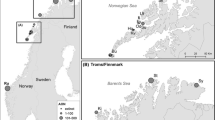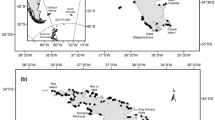Abstract
The striated caracara is a rare and specialised raptor, with a distribution restricted to outer islands of southern South America and the Falklands, where it lives in a unique obligate association with seabirds and seals. Despite its tameness, interesting adaptations and the fact that it is classified as near-threatened, there is virtually no published quantitative information on its demography, ecology and behaviour. We carried out a study on New Island, West Falklands, where the species was eradicated due to heavy persecution up to the 1960s. Recolonisation started after 1972 and presently there are an estimated 85 adult territorial pairs plus ca. 130 non-territorial immatures, representing an overall density of 15.5 striated caracaras per km2. The population is estimated to have increased by 15% per year over the past 3 decades, with the result that New Island now harbours the largest known breeding aggregation on a single island in the entire breeding range of the species. The spring and summer diet of striated caracaras on New Island is dominated by one small seabird, the thin-billed prion Pachyptila belcheri. An estimated 25,000 adult and sub-adult prions are consumed every year, but this possibly represents less than 1% of the local population. The diet of different pairs displayed significant differences, which were probably related to differences in the availability of prey types between territories. Breeding success in recent years was very high, suggesting that conditions are good and the population may not yet have reached the island’s carrying capacity.


Similar content being viewed by others
References
Barton NWH, Houston DC (1993) A comparison of digestive efficiency in birds of prey. Ibis 135:363–371
BirdLife International (2004) Threatened birds of the world 2004. CD-Rom, Cambridge UK: BirdLife International
Brown L, Amadon D (1968) Eagles, Hawks and Falcons of the World. Country Life Books, Feltham
Catry P, Campos A, Segurado P, Silva M, Strange I (2003) Population census and nesting habitat selection of thin-billed prion Pachyptila belcheri on New Island, Falkland Islands. Polar Biol 26:202–207
Catry P, Silva MC, MacKay S, Campos A, Masello J, Quillfeldt P, Strange IJ (2007) Can thin-billed prions Pachyptila belcheri breed successfully on an island with introduced rats, mice and cats? The case of New Island, Falkland Islands. Polar Biol 30:391–394
Cramp S, Simmons KEL (1980) The Birds of the Western Palearctic, vol II. Oxford University Press, Oxford
Del Hoyo J, Elliot A, Sargatal J (eds) (1994) Handbook of the birds of the world, vol II. Lynx Edicions, Barcelona
Kenward RE, Marcstrom V, Karlbom M (1981) Goshawk winter ecology in Swedish pheasant habitats. J Wildl Manag 45:397–408
Marín M, Kusch A, Oehler D, Driechman S (2006) Distribution, breeding and status of the striated caracara Phalcoboenus australis (Gmelin 1788) in Southern Chile. An Inst Patagonia (Chile) 34:65–74
Matias R, Catry P (2008) The diet of feral cats at New Island, Falkland Islands, and possible impact on breeding seabirds. Polar Biol 31:609–616
Newton I, Rothery P (2005) The timing, duration and pattern of moult and its relationship to breeding in a population of the European greenfinch Carduelis chloris. Ibis 147:667–679
Olendorff RR (1974) Some quantitative aspects of growth in three species of Buteos. Condor 76:466–468
Payne RB (1972) Mechanisms and control of moult. In: Farner DS, King JR (eds) Avian biology, vol 2. Academic Press, New York, pp 103–155
Phillips RA, Thompson DR, Hamer KC (1999) The impact of great skua predation on seabird populations at St Kilda: a bioenergetics model. J Appl Ecol 36:218–232
Pütz K, Clausen AP, Huin N, Croxall JP (2003) Re-evaluation of historical rockhopper penguin population data in the Falkland islands. Waterbirds 26:169–175
Rutz C (2003) Assessing the breeding season diet of goshawks Accipiter gentilis: biases of plucking analysis quantified by means of continuous radio-monitoring. J Zool Lond 259:209–217
Smith RIL, Prince PA (1985) The natural history of Beauchêne Island. Biol J Linn Soc 24:233–283
Strange IJ (1980) The thin-billed prion Pachyptila belcheri, at New Island, Falkland Islands. Gerfaut 70:411–445
Strange IJ (1996) The striated caracara Phalcoboenus australis in the Falkland Islands. Author’s Edition, Falkland Islands
Strange IJ, Catry P, Strange G, Quillfeldt P (2007) New Island, Falkland Islands. A South Atlantic Wildlife Sanctuary for Conservation Management. New Island Conservation Trust, London. 152 pp
Thompson D, Strange IJ, Riddy M, Duck CD (2005) The size and status of the population of southern sea lions Otaria flavescens in the Falkland Islands. Biol Conserv 121:357–367
Votier SC, Bearhop S, Ratcliffe N, Phillips RA, Furness RW (2004) Predation by great skuas at a large Shetland seabird colony. J Appl Ecol 41:1117–1128
Warham J (1990) The petrels. Their ecology and breeding systems. Academic Press, London
Woods RW (2007) The distribution and abundance of the striated caracara Phalcoboenus australis in the Falklands, 2006. Falklands Conservation, Stanley
Woods RW, Woods A (1997) Atlas of the breeding birds of the Falkland Islands. Anthony Nelson, Oswestry
Woods RW, Smith JG (1999) The distribution and abundance of the striated caracara Phalcoboenus australis in the Falklands, 1997–1998. Falklands Conservation, Stanley
Acknowledgments
The New Island Conservation Trust, an NGO and charity, supported field studies on their New Island reserve, through the supply of research facilities, accommodation and subsistence on the island. This study was financed by Fundação para a Ciência e Tecnologia (FCT-Portugal) as part of the Programa Plurianual (UI&D 331/94) and by research grants Praxis XXI BPD/11631/02 and SFRH/BPD/30031/2006 to PC. Further support was received from the Falkland Islands Government and the Foreign & Commonwealth Office through an Overseas Territories Environment Programme (OTEP) grant (FAL 201). Maria Strange, Shona Strange and Helen Otley provided important logistical and moral support in the field and in Stanley. We thank three anonymous referees for helpful comments on the manuscript. All work was approved by the Falkland Islands Government (Environmental Planning Office).
Author information
Authors and Affiliations
Corresponding author
Rights and permissions
About this article
Cite this article
Catry, P., Lecoq, M. & Strange, I.J. Population growth and density, diet and breeding success of striated caracaras Phalcoboenus australis on New Island, Falkland Islands. Polar Biol 31, 1167–1174 (2008). https://doi.org/10.1007/s00300-008-0454-8
Received:
Revised:
Accepted:
Published:
Issue Date:
DOI: https://doi.org/10.1007/s00300-008-0454-8




